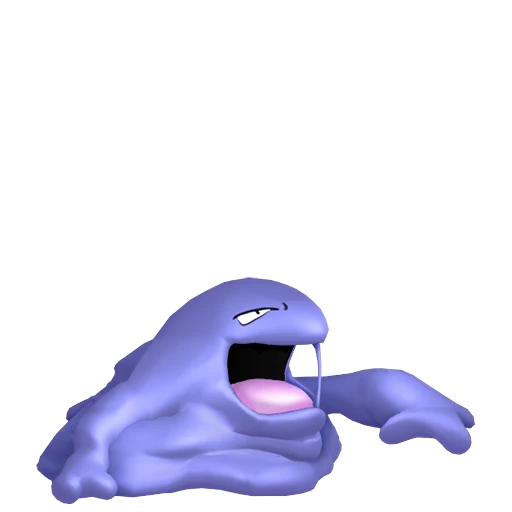
Muk
(1) : generation-i
Muk (#89) is a pure Poison-type Pokémon known for its amorphous, sludge-like body that oozes toxic substances wherever it goes. Its stench is so overpowering that even weeds wilt in its wake! Interestingly, Muk’s body composition changes based on its environment, with its Alolan form becoming a vibrant mix of Poison and Dark types.
Votes
2
Favorites
0
Caught
0
2-0
100.00%
Votes for Muk
Bio
Muk: Complete Biography, Stats, Evolution, Lore, and Trading Card Information
Muk is one of the most iconic Poison-type Pokémon in the Pokémon franchise, known for its amorphous, sludge-like appearance and formidable presence in both games and lore. As the evolved form of Grimer, Muk has fascinated trainers since its debut in Generation I. This comprehensive biography covers everything you need to know about Muk, including its Pokédex number (#89), Pokémon stats, evolution chain, lore, and its role in the Pokémon Trading Card Game.
Muk Overview
- Pokédex Number: #89
- Type: Poison (Alolan Muk is Poison/Dark)
- Evolution Chain: Grimer → Muk
- Generation Debut: Generation I (Pokémon Red and Blue)
Muk is characterized by its large, amorphous body composed of toxic sludge. Its body constantly oozes and emits a powerful, unpleasant odor that marks its territory and deters foes. Muk’s design and lore represent the environmental themes of pollution and toxicity, making it a unique and memorable Pokémon throughout the franchise.
Muk Evolution: From Grimer to Muk
Muk evolves from Grimer, making it the final evolution in its line. The evolution chain is straightforward:
- Grimer (#88) → Muk (#89)
- Evolution Method: Grimer evolves into Muk starting at level 38.
In the Alola region, Grimer and Muk have unique regional forms. Alolan Muk is a dual-type Poison/Dark Pokémon, featuring a vibrant, multicolored appearance. The Alolan forms evolve in the same way, by leveling up Grimer (Alola Form) at level 38.
Muk Stats and Competitive Information
Muk’s stats make it a durable and powerful Poison-type Pokémon, especially in battles where status effects and resistances are key. Here are Muk’s base stats:
Base Stats (Kanto/regular Muk):
- HP: 105
- Attack: 105
- Defense: 75
- Special Attack: 65
- Special Defense: 100
- Speed: 50
Muk’s high HP and solid Attack allow it to absorb hits and deal out significant damage. Its Special Defense is also notable, making it effective against special attackers. Alolan Muk gains an additional Dark typing, which grants it new resistances and access to unique moves.
Notable Moves:
- Sludge Bomb
- Gunk Shot
- Toxic
- Acid Armor
- Shadow Sneak (Alolan Muk)
- Knock Off (Alolan Muk)
Muk’s movepool allows it to serve various roles, from tanking hits to spreading poison or disrupting opponents’ strategies.
Muk Lore: The Polluting Pokémon
Muk is renowned in Pokémon lore for its connection to pollution and environmental hazards. According to multiple Pokédex entries, Muk’s body is made entirely of toxic, viscous sludge that can corrode anything it touches. The stench it emits is so powerful that it can cause fainting in humans from over a mile away.
Interesting Lore Facts:
- Habitat: Muk is often found in heavily polluted areas such as industrial zones, sewers, and garbage dumps.
- Alolan Variant: In the Alola region, Muk’s body has adapted to new toxins, resulting in its rainbow coloration and the ability to digest a wide variety of materials, including garbage.
- Pokédex Trivia: Muk’s presence in an area is considered a sign of severe pollution. In some stories, Muk is used by cities to help break down waste, showing a positive side to its toxic abilities.
Muk’s lore reflects environmental themes, using its existence as a symbol of pollution’s impact on the world and nature’s ability to adapt.
Muk in the Pokémon Trading Card Game
Muk has appeared in the Pokémon Trading Card Game (TCG) since the original Jungle expansion. Its cards often focus on status effects like Poison and Abilities that disrupt opponents. The Muk trading card is sought after by collectors and competitive players alike for its unique abilities and historical significance.
Notable Muk Trading Cards:
- Jungle Muk (1999): Famous for its “Toxic Gas” Pokémon Power, which shuts down other Pokémon Powers.
- Alolan Muk (Sun & Moon expansions): Features Abilities to block Basic Pokémon abilities and powerful attacks combining Poison and Dark-type effects.
- Team Rocket Muk: Known for its menacing artwork and useful moves in the TCG meta.
Muk’s trading cards often emphasize its disruptive potential, mirroring its in-game role as a status-spreader and wall.
Muk in Popular Culture and Media
Muk has appeared in the Pokémon anime, most notably as one of Ash Ketchum’s team members. Ash’s Muk is remembered for its affectionate nature and comedic moments, often glomping Professor Oak with its slimy body. Muk also appears in various manga, movies, and merchandise, cementing its legacy as a fan-favorite Poison-type Pokémon.
Summary: Why Muk Remains a Classic Pokémon
Muk’s enduring popularity stems from its unique design, compelling lore, and versatile role in both games and the Pokémon TCG. Whether you’re interested in Muk stats for competitive battling, its trading card history, or its evolution from Grimer, Muk offers a fascinating look at how Pokémon can embody important themes and provide deep gameplay options. With its Pokédex number (#89) and unmistakable presence, Muk continues to be a beloved part of the Pokémon universe for trainers new and old.
Keywords: Pokémon, Muk stats, Muk evolution, Muk lore, Muk trading card, Pokédex number 89, poison type, Grimer, Muk evolution chain.







